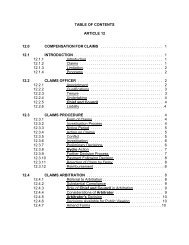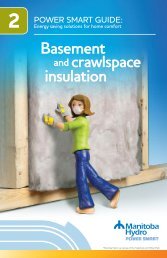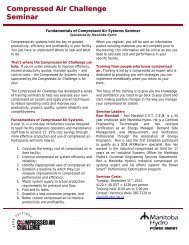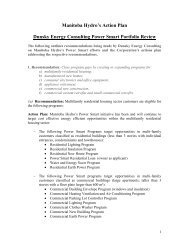Power Smart for Business: Using Energy Wisely in ... - Manitoba Hydro
Power Smart for Business: Using Energy Wisely in ... - Manitoba Hydro
Power Smart for Business: Using Energy Wisely in ... - Manitoba Hydro
You also want an ePaper? Increase the reach of your titles
YUMPU automatically turns print PDFs into web optimized ePapers that Google loves.
<strong>Us<strong>in</strong>g</strong> energy<br />
wisely <strong>in</strong> your<br />
restaurant<br />
*<strong>Manitoba</strong> <strong>Hydro</strong> is a licensee of the Trademark and Official Mark.
2<br />
COnSErVIng<br />
EnErgy<br />
restaurants are among<br />
the most energy <strong>in</strong>tensive<br />
commercial spaces. Simple<br />
low cost measures can add<br />
up. A restaurant operat<strong>in</strong>g<br />
with a profit marg<strong>in</strong> of<br />
5 per cent will need $10,000<br />
worth of sales to earn $500,<br />
which can often be achieved<br />
through low or no-cost<br />
energy sav<strong>in</strong>g measures.<br />
restaurants and commercial<br />
kitchens rely on many types<br />
of appliances and equipment.<br />
Save on energy and hot<br />
water costs with efficient<br />
appliances and by adopt<strong>in</strong>g<br />
some simple habits.<br />
Table of Contents<br />
Conserv<strong>in</strong>g <strong>Energy</strong> ................................ 2<br />
<strong>Power</strong> <strong>Smart</strong> Incentives . . . . . . . . . . . . . . . . . . . . . . . . . . . . . . .3<br />
What employees can do............................ 3<br />
What is payback? .................................. 4<br />
Appliances ......................................... 5<br />
Buy<strong>in</strong>g new? . . . . . . . . . . . . . . . . . . . . . . . . . . . . . . . . . . . . . . . .6<br />
Tips <strong>for</strong> <strong>Us<strong>in</strong>g</strong> Appliances . . . . . . . . . . . . . . . . . . . . .6 to 10<br />
Heat<strong>in</strong>g, Ventilation and Air Condition<strong>in</strong>g (HVAC)...11<br />
Central air handl<strong>in</strong>g systems/air conditioners . . . . . . .12<br />
Heat<strong>in</strong>g systems . . . . . . . . . . . . . . . . . . . . . . . . . . . . . . . . . . .12<br />
Natural gas pilots . . . . . . . . . . . . . . . . . . . . . . . . . . . . . . . . . .13<br />
Thermostats . . . . . . . . . . . . . . . . . . . . . . . . . . . . . . . . . . . . . .13<br />
Ventilation . . . . . . . . . . . . . . . . . . . . . . . . . . . . . . . . . . . . . . . . .13<br />
Light<strong>in</strong>g ..........................................14<br />
Water . . . . . . . . . . . . . . . . . . . . . . . . . . . . . . . . . . . . . . . . . . . . 17<br />
Faucets and fixtures . . . . . . . . . . . . . . . . . . . . . . . . . . . . . . .18<br />
Hot water . . . . . . . . . . . . . . . . . . . . . . . . . . . . . . . . . . . . . . . . .18<br />
Leaks . . . . . . . . . . . . . . . . . . . . . . . . . . . . . . . . . . . . . . . . . . . . . .18<br />
Pre-r<strong>in</strong>se spray valves . . . . . . . . . . . . . . . . . . . . . . . . . . . . .19<br />
Toilets . . . . . . . . . . . . . . . . . . . . . . . . . . . . . . . . . . . . . . . . . . . . .19
<strong>Power</strong> <strong>Smart</strong> <strong>in</strong>centives<br />
<strong>Manitoba</strong> <strong>Hydro</strong> offers <strong>in</strong>centives <strong>for</strong> many<br />
equipment upgrades and retrofit projects .<br />
For up-to-date <strong>in</strong><strong>for</strong>mation, visit our website<br />
at: www.hydro.mb.ca/psfb<br />
With the help of <strong>Power</strong> <strong>Smart</strong> <strong>in</strong>centives, you<br />
can often recover the cost of <strong>in</strong>stall<strong>in</strong>g approved<br />
energy efficient technologies <strong>in</strong> only a few years .<br />
Understand typical<br />
energy use <strong>in</strong> restaurants<br />
Learn how you can determ<strong>in</strong>e your energy use.<br />
To achieve persistent energy sav<strong>in</strong>gs:<br />
1. Determ<strong>in</strong>e your energy use (audit, survey).<br />
2. Cultivate staff support as described <strong>in</strong><br />
“What employees can do”.<br />
3. Review measures <strong>in</strong> this guide.<br />
4. Integrate a conservation/energy sav<strong>in</strong>gs plan<br />
<strong>in</strong>to your company procedures that encourages<br />
regular review of energy use.<br />
Some changes may be as simple as remember<strong>in</strong>g<br />
to turn off the lights when you leave a room. If<br />
you are ready to purchase new appliances, look <strong>for</strong><br />
ENERGY STAR® qualified replacements. For more<br />
extensive energy upgrades, such as retrofitt<strong>in</strong>g<br />
light<strong>in</strong>g, <strong>Manitoba</strong> <strong>Hydro</strong> can offer technical guidance<br />
through <strong>Power</strong> <strong>Smart</strong>* <strong>for</strong> <strong>Bus<strong>in</strong>ess</strong> programs.<br />
Encourage employees to adopt the practices outl<strong>in</strong>ed<br />
<strong>in</strong> this booklet. Discuss energy conservation measures<br />
with all employees. Offer specialized tra<strong>in</strong><strong>in</strong>g <strong>for</strong><br />
operations and ma<strong>in</strong>tenance staff.<br />
Encourage staff to:<br />
• Turn off lights <strong>in</strong> unoccupied refrigerated areas<br />
and shut doors. Post signs or posters as rem<strong>in</strong>ders.<br />
• Report uncom<strong>for</strong>table temperatures to the office<br />
manager, <strong>in</strong>stead of alter<strong>in</strong>g the thermostat.<br />
Contact us<br />
What employees can do<br />
For more <strong>in</strong><strong>for</strong>mation about how your bus<strong>in</strong>ess can<br />
save energy, contact your local <strong>Manitoba</strong> <strong>Hydro</strong><br />
<strong>Energy</strong> Services Advisor or a <strong>Power</strong> <strong>Smart</strong> <strong>for</strong> <strong>Bus<strong>in</strong>ess</strong><br />
Commercial Sales or Market<strong>in</strong>g Representative at:<br />
Telephone: 360-3676 <strong>in</strong> W<strong>in</strong>nipeg<br />
Toll-free: 1-888-MBHYDRO (1-888-624-9376)<br />
Email: powersmart<strong>for</strong>bus<strong>in</strong>ess@hydro.mb.ca<br />
Web: www.hydro.mb.ca/psfb<br />
Helpful l<strong>in</strong>ks and resources<br />
ENERGUIDE:<br />
http://oee.nrcan.gc.ca/energuide/<strong>in</strong>dex.cfm<br />
ENERGY STAR®:<br />
www.energystar.gov<br />
Natural Resources Canada (NRCAN):<br />
http://oee.nrcan.gc.ca<br />
Waste disposal facilities<br />
Listed <strong>in</strong> the W<strong>in</strong>nipeg Yellow Pages or on<br />
http://mts.yellowpages.ca under:<br />
• Hazardous waste removal<br />
• Waste reduction and disposal service<br />
• Scrap metal<br />
(to recycle metal components from light<strong>in</strong>g systems)<br />
• Keep furniture away from radiators and make sure<br />
w<strong>in</strong>dows are closed when the room is be<strong>in</strong>g heated<br />
or air conditioned.<br />
• <strong>Power</strong> down appliances, equipment, and other<br />
electronics when not <strong>in</strong> use. This <strong>in</strong>cludes unplugg<strong>in</strong>g<br />
power strips at the end of the day, as they consume<br />
energy even when equipment is shut off.<br />
• Turn off computers and monitors at the end of the<br />
day, if they won’t be used aga<strong>in</strong> <strong>for</strong> many hours.<br />
3
4<br />
Payback<br />
What is payback?<br />
Payback is the amount of time it<br />
takes <strong>for</strong> the sav<strong>in</strong>gs earned by<br />
your upgrade to equal the cost<br />
of the upgrade, or “pay it back.”<br />
Future sav<strong>in</strong>gs depend on<br />
the accuracy of calculations,<br />
equipment per<strong>for</strong>mance, and<br />
energy prices.<br />
Restaurant <strong>Energy</strong><br />
Cost Breakdown<br />
Light<strong>in</strong>g<br />
10%<br />
Ventilation, 6%<br />
Cool<strong>in</strong>g, 7%<br />
Water<br />
Heat<strong>in</strong>g<br />
16%<br />
Other, 4%<br />
refrigeration<br />
16%<br />
Note: Computers and office equipment total<br />
less than 1 per cent. May not total 100 due<br />
to round<strong>in</strong>g.<br />
© E Source, data from <strong>Energy</strong> In<strong>for</strong>mation<br />
Adm<strong>in</strong>istration<br />
Cook<strong>in</strong>g<br />
25%<br />
Space<br />
Heat<strong>in</strong>g<br />
17%<br />
To make an <strong>in</strong><strong>for</strong>med decision,<br />
look at both the expected return<br />
or cash flow projection, and<br />
the risk that the return will not<br />
be achieved. Also, weigh other<br />
benefits of energy efficiency<br />
measures, such as improved<br />
build<strong>in</strong>g com<strong>for</strong>t, <strong>in</strong>creased<br />
build<strong>in</strong>g value, and reduced<br />
greenhouse gas emissions.<br />
Simple payback<br />
If you want to <strong>in</strong>stall new<br />
equipment or adopt new<br />
measures, simple payback will<br />
<strong>in</strong>dicate the amount of time<br />
needed <strong>for</strong> energy sav<strong>in</strong>gs to<br />
equal the purchase price.<br />
For example, if a new energyefficient<br />
measure costs<br />
$10,000 and saves $1,000<br />
<strong>in</strong> energy costs each year, the<br />
simple payback is 10 years.<br />
You can estimate simple payback<br />
on new light<strong>in</strong>g us<strong>in</strong>g the<br />
Simple Payback Calculator on<br />
Natural Resources Canada’s<br />
(NRCAN) website at:<br />
http://oee.nrcan.gc.ca/<br />
commercial/technical-<strong>in</strong>fo/tools.<br />
You can also view simple<br />
calculations of how much you<br />
could save by us<strong>in</strong>g more efficient<br />
equipment at: http://oee.nrcan.<br />
gc.ca/commercial/equipment.<br />
Incremental<br />
payback<br />
If you are <strong>in</strong>stall<strong>in</strong>g a new type<br />
of equipment or if your old<br />
equipment is at the end of its<br />
life-cycle, <strong>in</strong>cremental payback<br />
will tell you the length of time<br />
needed to pay <strong>for</strong> the difference<br />
between an efficient and less<br />
efficient unit.<br />
For example, suppose that an<br />
energy-efficient replacement<br />
model costs $700 and a less<br />
efficient model costs $500.<br />
If you can save $100 a year<br />
by buy<strong>in</strong>g the efficient model,<br />
the <strong>in</strong>cremental payback of<br />
the efficient replacement<br />
model is two years, compared<br />
with buy<strong>in</strong>g the less efficient<br />
replacement model.<br />
Please note that some<br />
applications do not<br />
differentiate between simple<br />
and <strong>in</strong>cremental payback.
Appliances<br />
Did you know... that approximately 25 per cent of the energy consumed <strong>in</strong> a commercial kitchen is<br />
from the appliances used <strong>in</strong> food preparation? How you use your appliances is just as important as<br />
which appliances you buy.<br />
Visit www.hydro.mb.ca/psfb to see if there is a <strong>Power</strong> <strong>Smart</strong> program available to help your restaurant<br />
serve great food while sav<strong>in</strong>g energy and money.<br />
To ensure your equipment works efficiently, start with these general tips:<br />
Read the owner’s manual:<br />
The owner’s manual has <strong>in</strong><strong>for</strong>mation to help you<br />
operate the appliance at its highest efficiency.<br />
Determ<strong>in</strong>e appliance start-up times:<br />
Turn<strong>in</strong>g on all of the appliances first th<strong>in</strong>g <strong>in</strong> the<br />
morn<strong>in</strong>g means energy is be<strong>in</strong>g wasted. Choose<br />
start-up times <strong>for</strong> each appliance, so that they are<br />
ready to use when needed.<br />
Ensure optimal temperatures:<br />
Appliances can overheat and run at too hot a<br />
temperature. Rout<strong>in</strong>ely check each appliance to<br />
ensure it runs at its optimal temperature.<br />
Clean<strong>in</strong>g and ma<strong>in</strong>tenance:<br />
Rout<strong>in</strong>ely clean every appliance to elim<strong>in</strong>ate food<br />
build-up. Dirty appliances can have <strong>in</strong>efficient<br />
heat transfer that results <strong>in</strong> uneven cook<strong>in</strong>g and<br />
can cause break-downs. Follow the ma<strong>in</strong>tenance<br />
recommended <strong>in</strong> your owner’s manual.<br />
Recalibrate your equipment<br />
to help ma<strong>in</strong>ta<strong>in</strong> efficiency:<br />
Equipment, such as thermostats and control<br />
systems, can fall out of calibration. Check and<br />
recalibrate to ensure you cook at the right<br />
temperature. Repair or replace broken control<br />
panels on ovens, steamers, and other appliances<br />
that feature control systems.<br />
Check pilot lights:<br />
Typically, older gas-burn<strong>in</strong>g appliances have pilot<br />
lights, which use a constant stream of gas to stay<br />
lit. Check pilot flames to make sure you use only as<br />
much gas as you need. You can spot an over-fired<br />
pilot light by its tall yellow flame. Adjust flames so<br />
they are bullet-shaped and mostly blue.<br />
5
6<br />
Appliances<br />
Buy<strong>in</strong>g new?<br />
<strong>Energy</strong> efficient appliances have many benefits.<br />
Not only do they use less energy, they also have:<br />
• fewer temperature variations;<br />
• shorter cook times;<br />
• higher production rates;<br />
• less heat loss.<br />
When you are ready to buy equipment:<br />
Look <strong>for</strong> <strong>in</strong>sulated cook<strong>in</strong>g equipment (e.g. fryers,<br />
ovens, coffee mach<strong>in</strong>es). Insulation reta<strong>in</strong>s heat, so<br />
equipment uses less energy to stay hot.<br />
Th<strong>in</strong>k about the capacity. Evaluate your food<br />
production needs and try to buy appliances that<br />
match your needs on a pounds-per-hour basis.<br />
Oversized appliances can cause higher capital and<br />
operat<strong>in</strong>g costs.<br />
Purchase equipment with high EnerGuide rat<strong>in</strong>gs or<br />
ENERGY STAR® labell<strong>in</strong>g, such as:<br />
• Boilers, • Microwave ovens,<br />
• Freezers, • Fryers,<br />
• Furnaces, • Hot water tanks,<br />
• Griddles, • Hold<strong>in</strong>g tanks,<br />
• Refrigerators, • Steam cookers,<br />
• Convection ovens, <strong>in</strong>clud<strong>in</strong>g steamer models,<br />
• Dishwashers/ware-washers,<br />
• Office and computer equipment,<br />
• and any other specialized cook<strong>in</strong>g<br />
equipment or appliances.<br />
Visit: www.energystar.gov/productdevelopment<br />
<strong>for</strong> a current list of ENERGY STAR® appliances.<br />
Tips <strong>for</strong> us<strong>in</strong>g appliances:<br />
Brais<strong>in</strong>g pans<br />
Dur<strong>in</strong>g cook<strong>in</strong>g, close the lid.<br />
You use 50 per cent less energy by clos<strong>in</strong>g the pan’s<br />
lid dur<strong>in</strong>g periods of extended use.<br />
Buy an <strong>in</strong>sulated brais<strong>in</strong>g pan.<br />
Insulation helps reta<strong>in</strong> heat, so you use less energy.<br />
Broilers<br />
Cut preheat time.<br />
Typically, a broiler only takes 20 to 30 m<strong>in</strong>utes to<br />
preheat. Heat<strong>in</strong>g up your broiler earlier, wastes<br />
energy and heats up your kitchen, which causes<br />
your air conditioner to work harder.<br />
Elim<strong>in</strong>ate standby time.<br />
Turn your broiler down or off whenever possible.<br />
Or turn off a section, when cook<strong>in</strong>g smaller<br />
amounts of food.<br />
Use your griddle.<br />
A griddle can be a good alternative to broilers.<br />
Thermostatically controlled griddles use less energy<br />
than broilers. Grooved griddles can sear “grill marks”<br />
onto foods so they look broiled.<br />
Align broilers with exhaust hoods.<br />
Check that your broiler is placed under the exhaust<br />
hood and pushed back aga<strong>in</strong>st the rear wall. This<br />
ensures the heat and smoke are exhausted properly.<br />
Pasta cookers<br />
Use the m<strong>in</strong>imum sett<strong>in</strong>g.<br />
Food cooks just as quickly at the m<strong>in</strong>imum<br />
sett<strong>in</strong>g required to ma<strong>in</strong>ta<strong>in</strong> a boil, as it does<br />
at the highest sett<strong>in</strong>g.<br />
Cut the idle time or shut off when not <strong>in</strong> use.<br />
A pasta cooker stand<strong>in</strong>g by at less than boil<strong>in</strong>g<br />
temperature uses less energy than a pasta cooker<br />
runn<strong>in</strong>g a constant boil.
Appliances<br />
Dishwashers<br />
Fully load the dishwasher.<br />
A half-empty dishwasher uses the same amount of<br />
energy and hot water as a full one.<br />
Ensure the dishwasher is equipped with either<br />
a booster heater, a po<strong>in</strong>t of use hot water tank,<br />
or a natural gas tank less water heater.<br />
For manual dishwash<strong>in</strong>g and automatic<br />
dishwashers, f<strong>in</strong>al r<strong>in</strong>se water temperature may<br />
need to be as high as 82°C (180°F). For safety<br />
reasons, the booster heater can provide the<br />
adequate temperature when required.<br />
Consider features like gray water recovery,<br />
slow temperature rise, and restricted r<strong>in</strong>ses.<br />
A gray water heat recovery system recovers some<br />
of the heat from dra<strong>in</strong> water and uses it to reheat<br />
supply water. A slow temperature rise gradually<br />
<strong>in</strong>creases water temperature, which <strong>in</strong> turn reduces<br />
energy use. Restricted r<strong>in</strong>ses will reduce your water<br />
usage by 30 to 35 per cent per wash.<br />
Ensure that your dishwasher is properly sized<br />
<strong>for</strong> your restaurant.<br />
A too large or too small dishwasher can result <strong>in</strong><br />
a loss of energy. Talk to your supplier/contractor<br />
about appropriate siz<strong>in</strong>g <strong>for</strong> your restaurant.<br />
Make sure your dishwasher is professionally<br />
<strong>in</strong>stalled and set up.<br />
If you start to notice that your dishes are<br />
consistently not cleaned to satisfactory levels,<br />
call your dealer or a repair professional. Hav<strong>in</strong>g to<br />
rewash dishes is not only a headache but also a<br />
huge waste of energy.<br />
Fryers<br />
Cut preheat time.<br />
Typically, fryers only need 10 to 15 m<strong>in</strong>utes<br />
to preheat.<br />
Reduce thermostat dur<strong>in</strong>g times of low use<br />
or turn off the fryer.<br />
The lower temperature will reduce energy usage as<br />
well as extend oil life. Regularly clean oil filters as well.<br />
Pack shorten<strong>in</strong>g and melt accord<strong>in</strong>gly.<br />
For solid shorten<strong>in</strong>g, make sure it is solidly<br />
packed be<strong>for</strong>e you turn on the fryer. Melt<br />
shorten<strong>in</strong>g at a moderate temperature, and<br />
then <strong>in</strong>crease the temperature <strong>for</strong> cook<strong>in</strong>g.<br />
Fry<strong>in</strong>g tips:<br />
• Avoid fry<strong>in</strong>g at higher than<br />
necessary temperatures.<br />
• Fill fryer baskets to the recommended capacity.<br />
Overload<strong>in</strong>g <strong>in</strong>creases cook<strong>in</strong>g time.<br />
• Ensure food pieces are roughly the<br />
same size. This ensures even cook<strong>in</strong>g.<br />
• Cover fryer dur<strong>in</strong>g slow periods<br />
to m<strong>in</strong>imize heat loss.<br />
• Check the cook<strong>in</strong>g oil temperature with<br />
a commercial thermometer to ensure that<br />
heat<strong>in</strong>g elements or burners and controls<br />
are work<strong>in</strong>g properly.<br />
Hold<strong>in</strong>g cab<strong>in</strong>ets<br />
Buy <strong>in</strong>sulated hot food hold<strong>in</strong>g cab<strong>in</strong>ets.<br />
Insulation helps reta<strong>in</strong> heat, so you use less energy.<br />
Turn off cab<strong>in</strong>ets overnight.<br />
Don’t waste energy by heat<strong>in</strong>g empty space.<br />
Implement a shutdown schedule <strong>for</strong> your cab<strong>in</strong>ets<br />
to ensure they are off when you close <strong>for</strong> the night.<br />
7
8<br />
Appliances<br />
Ice mach<strong>in</strong>es<br />
Change your ice production time.<br />
Install a timer and shift ice production to<br />
night-time or off-peak hours. Ice mach<strong>in</strong>es that<br />
run dur<strong>in</strong>g the afternoon create more heat <strong>in</strong> your<br />
kitchen and add to your demand load.<br />
Shop smart:<br />
• Comparison shop <strong>for</strong> an efficient ice mach<strong>in</strong>e . Ice<br />
mach<strong>in</strong>e manufacturers voluntarily list the water and<br />
energy-use numbers <strong>for</strong> their ice-cube mach<strong>in</strong>es<br />
with the Air Condition<strong>in</strong>g and Refrigeration Institute.<br />
• Th<strong>in</strong>k about the capacity. Large ice mach<strong>in</strong>es are<br />
more efficient than smaller ones <strong>for</strong> restaurants –<br />
you can get twice the ice capacity at half the<br />
energy cost per pound of ice. A larger mach<strong>in</strong>e<br />
also makes it easier to shift all of your ice mak<strong>in</strong>g<br />
to night-time hours.<br />
Ovens and ranges<br />
Use the right size pot.<br />
The base of your pot should just cover the element.<br />
If the pot is too large, it will take more energy to heat<br />
the pot. If the pot is too small, energy is wasted.<br />
Check pot bottoms.<br />
Pots and pans with a smooth, flat bottom use less<br />
energy <strong>for</strong> cook<strong>in</strong>g, s<strong>in</strong>ce the pot is <strong>in</strong> full contact<br />
with the element. Food will also cook faster with the<br />
right type of pot.<br />
Ensure oven door seal is tight.<br />
You can check whether your door seal is tight by<br />
plac<strong>in</strong>g a lit flashlight <strong>in</strong>side a cold oven. Close the<br />
door. If you see light along the door edges, the seals<br />
need to be replaced. You can also check freezer and<br />
refrigerator seals this way.<br />
Preheat only when required.<br />
Depend<strong>in</strong>g on what you are cook<strong>in</strong>g <strong>in</strong> the oven,<br />
you may not need to preheat your oven.<br />
Keep it closed.<br />
Whenever you open the oven door, at least 20 per<br />
cent of the heat is lost. Instead of open<strong>in</strong>g the door<br />
to check on cook<strong>in</strong>g, look through the oven w<strong>in</strong>dow.<br />
refrigerators and freezers<br />
Set-up and operation:<br />
Follow manufacturer’s recommendations <strong>for</strong> shelf<br />
position and size.<br />
Make sure that enough ventilation is available<br />
<strong>for</strong> your refrigerator’s mechanical equipment.<br />
A one-<strong>in</strong>ch gap on the sides and four-<strong>in</strong>ch gap at the<br />
back are recommended to allow the condenser and<br />
fan to have access to a steady flow of air.<br />
Optimize the location of compressors,<br />
condensers, and refrigeration equipment.<br />
Place <strong>in</strong> cool surround<strong>in</strong>gs and avoid direct sunlight.<br />
Set operat<strong>in</strong>g temperatures as low as necessary<br />
to ensure optimum levels and ma<strong>in</strong>ta<strong>in</strong> consistent<br />
temperatures.<br />
The ideal temperature <strong>for</strong> refrigerators is<br />
3°C (37°F). If the temperature is lower, turn it up.<br />
The ideal temperature <strong>for</strong> freezers is<br />
18°C (0°F). If the temperature is lower, turn it up.<br />
Keep doors shut. Repeated fluctuations <strong>in</strong><br />
temperature will damage food quality and<br />
will cost money.<br />
Avoid heat build up – use as few lights as possible<br />
to illum<strong>in</strong>ate <strong>in</strong>teriors.<br />
Talk to your service company about the possibility of:<br />
• higher suction pressures,<br />
• lower condens<strong>in</strong>g pressures,<br />
• float<strong>in</strong>g head pressures.
Appliances<br />
Raise the evaporator temperature to the<br />
maximum level possible.<br />
Optimal refrigeration efficiency is achieved<br />
with ambient air relative humidity levels between<br />
40 to 55 per cent.<br />
Verify operation and efficiency of defrost timers and<br />
moisture sensors to ensure optimal per<strong>for</strong>mance.<br />
Turn off lights <strong>in</strong> unoccupied refrigerated areas.<br />
Optimize the defrost cycle based on seasonal,<br />
humidity, and load requirements by resett<strong>in</strong>g<br />
cycle frequency or <strong>in</strong>stall<strong>in</strong>g an automatic control.<br />
Control conditions to reduce refrigeration needs.<br />
Install:<br />
• a thermometer <strong>in</strong> each freezer to enable frequent<br />
temperature checks;<br />
• dehumidifier units to control humidity;<br />
• defrost controls;<br />
• evaporator fan motor controls;<br />
• sensors to monitor product temperature, <strong>in</strong>stead<br />
of air temperature <strong>in</strong> a cold storage area;<br />
• motion sensors to turn off lights <strong>in</strong> unoccupied<br />
refrigerated areas.<br />
Control the refrigeration system to operate only<br />
when a product needs cool<strong>in</strong>g.<br />
Purge non-condensables from the refrigeration<br />
system at each purge po<strong>in</strong>t.<br />
Ma<strong>in</strong>tenance and prevention:<br />
Regular ma<strong>in</strong>tenance and clean<strong>in</strong>g helps appliances<br />
to run at peak efficiency. Certa<strong>in</strong> signs <strong>in</strong>dicate that<br />
your appliance may need servic<strong>in</strong>g. Look <strong>for</strong>:<br />
• absence of fluid <strong>in</strong> the site glass;<br />
(This may <strong>in</strong>dicate that there is no<br />
refrigerant <strong>in</strong> that portion of the system.)<br />
• high pressure read<strong>in</strong>gs on any gauges;<br />
(This may <strong>in</strong>dicate problems;)<br />
• new noises from the refrigeration room;<br />
(This may <strong>in</strong>dicate mechanical problems.)<br />
If your appliances show any of these signs,<br />
contact a service professional.<br />
Consider contract<strong>in</strong>g monthly/bimonthly<br />
ma<strong>in</strong>tenance.<br />
Per<strong>for</strong>m regular checks and <strong>in</strong>spect:<br />
• mechanical and electrical equipment,<br />
• filters,<br />
• refrigerant charge,<br />
• economizer,<br />
• cab<strong>in</strong>et panels,<br />
• unusual noise, vibration, and decrease <strong>in</strong><br />
per<strong>for</strong>mance of compressors/motors.<br />
Schedule regular ma<strong>in</strong>tenance checks <strong>for</strong><br />
fans, evaporator and condenser coils, and<br />
compressors.<br />
Clean this equipment regularly. Dirt build-up<br />
reduces efficiency. Ensure the evaporator coils<br />
are kept free of ice.<br />
Manage anti-sweat heaters and defrost cycles<br />
and turn off when not required.<br />
Keep cold air supply and return registers clean<br />
and clear of product.<br />
Ensure hot and cold water bas<strong>in</strong>s are clean.<br />
Clean and dis<strong>in</strong>fect condensate dra<strong>in</strong> pan.<br />
Defrost freezers when ice build-up reaches<br />
5 mm thick.<br />
Check door seals and weather stripp<strong>in</strong>g regularly<br />
and repair if needed.<br />
Insert a piece of paper between a door and its<br />
frame. If the paper can be withdrawn easily, the<br />
gasket is not seal<strong>in</strong>g properly.<br />
Adjust door latches.<br />
Change filters regularly.<br />
Ensure compressor belts ma<strong>in</strong>ta<strong>in</strong> proper tension.<br />
Replace damaged and worn belts promptly.<br />
Replace all <strong>in</strong>sulation damaged by moisture.<br />
The presence of frost may <strong>in</strong>dicate a breakdown<br />
<strong>in</strong> <strong>in</strong>sulation.<br />
9
Appliances<br />
Steam cookers<br />
Reduce preheat time.<br />
M<strong>in</strong>imize amount of preheat<strong>in</strong>g <strong>in</strong> a pressurized<br />
boiler be<strong>for</strong>e use.<br />
Steam cook<strong>in</strong>g tips:<br />
• Thaw products prior to steam<strong>in</strong>g to reduce<br />
cook<strong>in</strong>g time.<br />
• Cook food loads <strong>in</strong> the largest amount possible.<br />
• Use per<strong>for</strong>ated pans.<br />
• Keep cavity door closed dur<strong>in</strong>g the entire<br />
steam cycle.<br />
Shut off dur<strong>in</strong>g slow times.<br />
Turn steam cooker off dur<strong>in</strong>g slow periods.<br />
Per<strong>for</strong>m regular clean<strong>in</strong>g and ma<strong>in</strong>tenance:<br />
• Flush boilers at least once a week, follow<strong>in</strong>g<br />
manufacturer’s <strong>in</strong>structions. Use clean<strong>in</strong>g<br />
chemicals if necessary due to hard water.<br />
• Use a water treatment system to reduce scal<strong>in</strong>g.<br />
• Remove all deposits, <strong>in</strong>clud<strong>in</strong>g rust, scale,<br />
and lime from external surfaces.<br />
• Repair all steam leaks, regardless<br />
of amount leak<strong>in</strong>g.<br />
Stock<strong>in</strong>g<br />
Size refrigerators and freezers to avoid over<br />
or under-load<strong>in</strong>g.<br />
Overloaded units disrupt air-flow patterns<br />
necessary to cool the products efficiently<br />
and allow deterioration to occur. Proper<br />
cool<strong>in</strong>g occurs when air can circulate freely.<br />
Under-loaded units waste energy – keep freezers<br />
full. It is easier to keep a full freezer at the correct<br />
temperature than a partially empty one.<br />
Load product when cool.<br />
Do not let refrigerated items warm-up dur<strong>in</strong>g<br />
delivery and/or restock<strong>in</strong>g. Shut down refrigeration<br />
areas where extensive load<strong>in</strong>g and unload<strong>in</strong>g occurs.<br />
Keep the doors closed as much as possible.<br />
Ensure freezer curta<strong>in</strong>s rema<strong>in</strong> <strong>in</strong> a vertical<br />
position to reta<strong>in</strong> cool air and keep warm air out.<br />
Defrost and re-cool dur<strong>in</strong>g off-peak hours.<br />
Rotate stock regularly.<br />
Defrost frozen goods <strong>in</strong> the refrigerator.<br />
Technical assistance and f<strong>in</strong>ancial <strong>in</strong>centives from<br />
<strong>Manitoba</strong> <strong>Hydro</strong>’s <strong>Power</strong> <strong>Smart</strong> <strong>for</strong> <strong>Bus<strong>in</strong>ess</strong> programs<br />
may be available to assist with more extensive upgrades:<br />
Increase <strong>in</strong>sulation thickness <strong>in</strong> walls, floors, and ceil<strong>in</strong>gs.<br />
Install high efficiency refrigeration equipment such as:<br />
• compressors; • outside air economizers;<br />
• ambient sub-cool<strong>in</strong>g; • evaporator and condenser fans;<br />
• case light<strong>in</strong>g fixtures; • heat recovery systems.<br />
• auto door closers, and add strip curta<strong>in</strong>s to walk-<strong>in</strong> doors;<br />
Use night covers on refrigeration and freezer units to keep out unwanted heat.<br />
Use hot gas defrost<strong>in</strong>g <strong>in</strong>stead ofelectric defrost<strong>in</strong>g.<br />
10
Heat<strong>in</strong>g,<br />
Ventilation and<br />
Air Condition<strong>in</strong>g<br />
(HVAC)<br />
Did you know... In most restaurants, heat<strong>in</strong>g, ventilation, and cool<strong>in</strong>g typically account <strong>for</strong> 40 per<br />
cent of energy costs? A great way to reduce energy consumption and offset ris<strong>in</strong>g fuel costs is to<br />
replace old, <strong>in</strong>efficient equipment with energy efficient technologies.<br />
F<strong>in</strong>ancial <strong>in</strong>centives are available to help with the added cost of efficiency upgrades and reduce the<br />
payback <strong>in</strong> energy sav<strong>in</strong>gs <strong>in</strong> just a few years or less.<br />
Visit www.hydro.mb.ca/psfb to see if there is a <strong>Power</strong> <strong>Smart</strong> program available to help your<br />
restaurant stay cool while sav<strong>in</strong>g energy and money.<br />
To ensure your equipment works efficiently, start with these general tips:<br />
Inspect, clean, and ma<strong>in</strong>ta<strong>in</strong> equipment regularly.<br />
Dirty heat transfer surfaces (heat<strong>in</strong>g and cool<strong>in</strong>g<br />
coils,) torn or misaligned ductwork, and miss<strong>in</strong>g or<br />
damaged equipment <strong>in</strong>sulation can dramatically<br />
lower the efficiency of your HVAC equipment. Clean<br />
and mend equipment, ductwork, and pip<strong>in</strong>g where<br />
you can. Also, keep louvers, grilles, and diffusers<br />
clear from obstructions.<br />
Rebalance HVAC system.<br />
Over time your system will become out of balance,<br />
potentially mov<strong>in</strong>g too much or too little air or fluid.<br />
Talk to a Test<strong>in</strong>g and Balanc<strong>in</strong>g (TAB) contractor <strong>for</strong><br />
more <strong>in</strong><strong>for</strong>mation on f<strong>in</strong>e tun<strong>in</strong>g your system to<br />
ensure its peak per<strong>for</strong>mance.<br />
Install an <strong>Energy</strong> Management System (EMS).<br />
If you have a centralized heat<strong>in</strong>g and cool<strong>in</strong>g system,<br />
an EMS may provide significant energy sav<strong>in</strong>gs.<br />
<strong>Energy</strong> Management Systems can automatically<br />
control light<strong>in</strong>g, fans, pumps, and other equipment<br />
to operate only when needed and often utilize setback<br />
and economizer strategies to m<strong>in</strong>imize energy<br />
use. Talk to a controls or energy expert to see if an<br />
EMS is right <strong>for</strong> you.<br />
11
12<br />
Heat<strong>in</strong>g, Ventilation and Air Condition<strong>in</strong>g (HVAC)<br />
Central air handl<strong>in</strong>g<br />
systems/air conditioners<br />
Keep w<strong>in</strong>dows and doors closed when the air<br />
condition<strong>in</strong>g is on.<br />
Replace an old, <strong>in</strong>efficient air condition<strong>in</strong>g unit<br />
with an energy efficient model.<br />
The follow<strong>in</strong>g measures may require professional<br />
help to ensure ma<strong>in</strong>ta<strong>in</strong><strong>in</strong>g adequate ventilation:<br />
• Increase mixed air temperatures to reduce<br />
volume of outside air. Mixed air temperatures<br />
are normally set at 13°C (55°F), but <strong>in</strong> some cases<br />
can be set as high as 16°C to 18°C (60°F)<br />
to 65°F) without caus<strong>in</strong>g problems.<br />
• Reset discharge temperatures if there are<br />
preheat or reheat coils. This may be useful if<br />
some areas overheat.<br />
• Reduce the discharge temperature to the<br />
lowest possible temperature to keep all heated<br />
areas com<strong>for</strong>table <strong>in</strong> w<strong>in</strong>ter. A similar method<br />
may be used <strong>for</strong> cool<strong>in</strong>g <strong>in</strong> the hot season.<br />
Heat<strong>in</strong>g systems<br />
Turn off equipment when it is not required.<br />
You can turn off:<br />
• boilers and furnaces <strong>in</strong> the spr<strong>in</strong>g and leave them<br />
off until fall, when the heat<strong>in</strong>g season starts;<br />
(Always follow manufacturers shut down, lay-up<br />
and start-up <strong>in</strong>structions.)<br />
• circulat<strong>in</strong>g pumps;<br />
• electric baseboard at the breaker;<br />
• unit ventilators and vestibule heaters to avoid<br />
heat<strong>in</strong>g these areas.<br />
Cut back on patio heater operation time.<br />
Make sure patio heaters are turned off when the<br />
patio is not <strong>in</strong> use. Look <strong>for</strong> opportunities to limit<br />
the number of heaters whenever the patio is not<br />
fully occupied.<br />
Technical assistance and f<strong>in</strong>ancial <strong>in</strong>centives from<br />
<strong>Manitoba</strong> <strong>Hydro</strong>’s <strong>Power</strong> <strong>Smart</strong> <strong>for</strong> <strong>Bus<strong>in</strong>ess</strong> programs<br />
may be available to assist with more extensive upgrades:<br />
Install a humidistat to control<br />
exhaust fans <strong>in</strong> high humidity areas,<br />
such as showers and wash<strong>in</strong>g areas.<br />
This ensures fans only come on to<br />
reduce the humidity to a preset value<br />
and then turn off.<br />
Ensure fans are turned off when not<br />
required. Connect them:<br />
• to occupancy sensors or time clocks;<br />
• to manual spr<strong>in</strong>g-wound or<br />
automatic times;<br />
• to illum<strong>in</strong>ated local manual switches;<br />
• <strong>in</strong> tandem with light switches.
Heat<strong>in</strong>g, Ventilation and Air Condition<strong>in</strong>g (HVAC)<br />
natural gas pilots<br />
Turn off a stand<strong>in</strong>g natural gas pilot <strong>in</strong> your<br />
space heat<strong>in</strong>g system every spr<strong>in</strong>g when<br />
the heat<strong>in</strong>g season ends.<br />
Natural gas pilots use as much as $5 to $10 worth of<br />
natural gas per month. This measure saves money if<br />
there is someone <strong>in</strong> your company who is able to turn<br />
the pilot lights off and re-light them aga<strong>in</strong>. However,<br />
if you have to call a tradesperson to re-light the pilots<br />
then it may not be worthwhile, depend<strong>in</strong>g on how<br />
many furnaces or boilers you have.<br />
Thermostats<br />
Install a programmable thermostat to<br />
automatically control temperature sett<strong>in</strong>gs.<br />
Significant sav<strong>in</strong>gs <strong>in</strong> operat<strong>in</strong>g costs may be<br />
realized by rais<strong>in</strong>g the build<strong>in</strong>g temperature sett<strong>in</strong>g<br />
dur<strong>in</strong>g cool<strong>in</strong>g season and lower<strong>in</strong>g the build<strong>in</strong>g<br />
temperature sett<strong>in</strong>g dur<strong>in</strong>g heat<strong>in</strong>g season.<br />
The amount of setback depends on the outside<br />
temperature and how long it takes to br<strong>in</strong>g the<br />
area back to normal temperature. Generally set the<br />
temperature <strong>for</strong> at least 26°C (78° F) <strong>in</strong> summer and<br />
16°C (60° F) <strong>in</strong> w<strong>in</strong>ter dur<strong>in</strong>g unoccupied periods.<br />
Ventilation<br />
Install controls on kitchen exhaust and make-up<br />
air systems that automatically reduce fan speeds<br />
dur<strong>in</strong>g idle cook<strong>in</strong>g.<br />
Variable speed, demand-based exhaust, and makeup<br />
air controls monitor your cook<strong>in</strong>g to match your<br />
ventilation needs, reduc<strong>in</strong>g excess energy use.<br />
Turn off washroom, kitchen/coffee room and<br />
general exhaust and supply fans when a room is<br />
unoccupied or at the end of the day.<br />
De-stratification or ceil<strong>in</strong>g fans should:<br />
• run all the time at a speed appropriate to the<br />
space <strong>in</strong> w<strong>in</strong>ter;<br />
• be operated to provide cool<strong>in</strong>g only when the<br />
room is be<strong>in</strong>g occupied <strong>in</strong> summer.<br />
13
14<br />
Light<strong>in</strong>g<br />
Did you know... the atmosphere and ambiance of a restaurant is just as important to its<br />
success as the menu items offered to the customer? Light<strong>in</strong>g is a key part <strong>in</strong> creat<strong>in</strong>g the<br />
correct mood but it doesn’t have to mean creat<strong>in</strong>g high energy bills!<br />
<strong>Energy</strong> efficient light<strong>in</strong>g is available <strong>in</strong> an assortment of styles, technologies, and colours.<br />
Visit www.hydro.mb.ca/psfb to see if there is a <strong>Power</strong> <strong>Smart</strong> program available to help<br />
your restaurant look good while sav<strong>in</strong>g energy and money.
Light<strong>in</strong>g<br />
Turn off lights manually:<br />
When you leave a room unoccupied<br />
or leave <strong>for</strong> the day.<br />
In rooms that are seldom used. Storerooms,<br />
utility rooms, washrooms, and meet<strong>in</strong>gs rooms<br />
do not need to be lit when not <strong>in</strong> use.<br />
Install devices to turn<br />
off lights automatically:<br />
Install occupancy sensors that turn the lights<br />
off when the room is unoccupied.<br />
Install a local light switch or occupancy sensor <strong>in</strong> rooms<br />
where the lights are controlled by a breaker panel.<br />
A less expensive alternative is to label and colourcode<br />
all circuit breakers, so everyone knows which<br />
breakers control which lights and can turn on only<br />
the lights that are needed.<br />
To turn off exterior lights dur<strong>in</strong>g the day, <strong>in</strong>stall<br />
a timer, a photocell switch, or a motion sensor.<br />
Per<strong>for</strong>m regular ma<strong>in</strong>tenance:<br />
Look <strong>for</strong> flak<strong>in</strong>g, chipp<strong>in</strong>g, and rust<strong>in</strong>g, metal show<strong>in</strong>g<br />
through the pa<strong>in</strong>t and/or layers of dust or dirt on<br />
fixture reflectors, as the fixture’s ability to reflect<br />
light will be <strong>in</strong>hibited.<br />
Look at the sockets, check <strong>for</strong> de<strong>for</strong>mation, crack<strong>in</strong>g<br />
or exposed metal contact, and note any difficulty <strong>in</strong><br />
lamp <strong>in</strong>stallation.<br />
Lens condition: Check <strong>for</strong> brittleness, crack<strong>in</strong>g,<br />
discolouration or yellow colour, glare, and pitt<strong>in</strong>g.<br />
Consider this:<br />
One CFL bulb equals seven <strong>in</strong>candescent bulbs.<br />
The life span of one CFL (compact fluorescent lamp)<br />
is 6 to 7 times greater than one <strong>in</strong>candescent. That<br />
saves you time and money if you switch to CFLs<br />
when consider<strong>in</strong>g labour and purchas<strong>in</strong>g costs.<br />
Consider your exist<strong>in</strong>g light<strong>in</strong>g level.<br />
Does your current light<strong>in</strong>g provide the quality and<br />
ambiance you want to achieve? If current light<strong>in</strong>g<br />
levels are too high, retrofitt<strong>in</strong>g to a lesser number<br />
of lamps or low light ballast is often adequate.<br />
In particular, review:<br />
Per<strong>for</strong>mance:<br />
Consider the speed and accuracy of work, fatigue,<br />
eye stra<strong>in</strong>, morale, and motivation of employees.<br />
Com<strong>for</strong>t:<br />
Is glare, reflected images, or adequate light fall<strong>in</strong>g<br />
on the task, or work area?<br />
Ambiance/light<strong>in</strong>g effects:<br />
What is the employee and customer perception<br />
of the space? What k<strong>in</strong>d of light<strong>in</strong>g effect is<br />
desired (direct, <strong>in</strong>direct, diffused, concentrated,<br />
task or ambient?)<br />
Light colour and temperature:<br />
Colour Render<strong>in</strong>g Index (CRI) <strong>in</strong>dicates how<br />
light sources affect object colour: the higher<br />
the number, the more likely the light source will<br />
render object colours well.<br />
Consider this:<br />
For fluorescent technologies, a CRI of 80 per<br />
cent and above is recommended. By switch<strong>in</strong>g<br />
to T8s, you are achiev<strong>in</strong>g 80% CRI, br<strong>in</strong>g<strong>in</strong>g you<br />
closer to daylight quality which can help you save<br />
money by be<strong>in</strong>g able to properly view due dates<br />
and food spoilage be<strong>for</strong>e they happen, provid<strong>in</strong>g a<br />
cleaner and safer work<strong>in</strong>g environment!<br />
Correlated Colour Temperature (CCT) describes<br />
the colour appearance of the source. While<br />
there are several colours available <strong>in</strong> T8 and<br />
T5 fluorescent light<strong>in</strong>g <strong>for</strong> neutral white light,<br />
consider us<strong>in</strong>g Cool White (4,100°K). For softer<br />
light<strong>in</strong>g, consider utiliz<strong>in</strong>g Soft White (3,500°K).<br />
15
Light<strong>in</strong>g<br />
Safely dispose of old<br />
fixtures and lamps<br />
Proper disposal and recycl<strong>in</strong>g is very important<br />
as old light fixtures may conta<strong>in</strong> polychlor<strong>in</strong>ated<br />
biphenyls, commonly known as PCBs. Release of<br />
PCBs <strong>in</strong>to the environment cont<strong>in</strong>ues to occur as a<br />
result of improper handl<strong>in</strong>g of hazardous waste.<br />
Identify<strong>in</strong>g lamp ballasts with PCBs<br />
To identify lamp ballasts with PCBs, contact<br />
manufacturers of ballasts and capacitors.<br />
Manufacturers use dist<strong>in</strong>ct catalogue and date<br />
codes to identify the product, manufacture date,<br />
and presence of hazardous material(s).<br />
Correctly <strong>in</strong>terpret<strong>in</strong>g the codes on the ballast<br />
is imperative <strong>in</strong> determ<strong>in</strong><strong>in</strong>g whether the ballast<br />
conta<strong>in</strong>s PCBs or not. Removal of a ballast from its<br />
mount <strong>in</strong> the fixture should only be done by qualified<br />
personnel after the circuit has been de-energized.<br />
Lamp ballasts conta<strong>in</strong><strong>in</strong>g PCBs are designated as<br />
hazardous waste. They must be properly handled<br />
and stored by a waste contractor until they can be<br />
properly destroyed (either by chemical treatment<br />
or <strong>in</strong>c<strong>in</strong>eration <strong>in</strong> accordance with prov<strong>in</strong>cial and<br />
federal regulations).<br />
Proper handl<strong>in</strong>g and recycl<strong>in</strong>g of<br />
lamps<br />
Consider the environment and purchase low<br />
mercury flourescent lamps, then recycle the lamps<br />
at the end of their life.<br />
Unbroken lamps should be packaged, labelled, and<br />
delivered to an approved contractor <strong>for</strong> proper<br />
disposal.<br />
Technical assistance and f<strong>in</strong>ancial Incentives from<br />
<strong>Manitoba</strong> <strong>Hydro</strong>’s <strong>Power</strong> <strong>Smart</strong> <strong>for</strong> <strong>Bus<strong>in</strong>ess</strong> programs<br />
may be available to assist with upgrades:<br />
Install energy efficient lamps and ballasts if lamps<br />
are on <strong>for</strong> 40 hours or more per week.<br />
Replace regular T-12 fluorescent lamps with<br />
T-8 fluorescent lamps and electronic ballasts.<br />
Replace <strong>in</strong>candescent lamps with compact fluorescents.<br />
Replace <strong>in</strong>candescent exit signs with new LED exit signs.<br />
LEDs are up to 90 per cent more efficient than<br />
neon systems with the same light output. The<br />
low-voltage wires (less than 50 volts) compared<br />
to neon (10,000 volts or more) do not deteriorate<br />
16<br />
Broken lamps should be stored <strong>in</strong> a sealable,<br />
non-metallic conta<strong>in</strong>er, labelled and an approved<br />
waste contractor should be contacted <strong>for</strong> proper<br />
disposal.<br />
Waste disposal facilities are listed <strong>in</strong> the W<strong>in</strong>nipeg<br />
yellow Pages under:<br />
• Hazardous waste removal<br />
• Waste reduction and disposal service<br />
Metal components from light<strong>in</strong>g systems may be<br />
recycled as scrap metal. To f<strong>in</strong>d companies that<br />
recycle these components, look <strong>in</strong> the W<strong>in</strong>nipeg<br />
yellow Pages under “scrap metal.”<br />
or pose a fire risk, which means less chance<br />
of property loss and lower <strong>in</strong>surance premiums.<br />
A 50,000 to 100,000 hour product life means<br />
fewer system changes, fewer disruptions, and lower<br />
ma<strong>in</strong>tenance costs. LEDs are more resistant to<br />
vibration, salt corrosion, temperature, humidity,<br />
and emit a specific wavelength of light that can be<br />
customized to match the colour of the sign face<br />
material. Electrical connections ensure that an outage<br />
of one LED does not affect the entire system.
Water<br />
Did you know... that thousands of litres of water (and money!) are flushed down the dra<strong>in</strong><br />
each year <strong>in</strong> a restaurant that doesn’t use any water sav<strong>in</strong>g measures?<br />
By <strong>in</strong>stall<strong>in</strong>g devices like low-flow spray valves and faucet aerators, you are sav<strong>in</strong>g on your<br />
water bill and on your electricity or natural gas bill, which is used to heat the water.<br />
Visit www.hydro.mb.ca/psfb to see if there is a <strong>Power</strong> <strong>Smart</strong> program available to help your<br />
restaurant conserve water while sav<strong>in</strong>g energy and money.<br />
17
18<br />
Water<br />
Faucets and fixtures<br />
2. Mark the water level with a waterproof<br />
felt pen every 500 ml (1/2 litre).<br />
3. Run faucet or shower at reasonable rate.<br />
Fill the pail <strong>for</strong> 10 seconds.<br />
4. Estimate, us<strong>in</strong>g the pen mark<strong>in</strong>gs, how<br />
much water filled the pail dur<strong>in</strong>g that time.<br />
5. Multiply by six the number of litres from<br />
Step 4 to calculate the flow per m<strong>in</strong>ute.<br />
Hot water<br />
Install water efficient fixtures or retrofit exist<strong>in</strong>g Reduce temperature of hot water.<br />
fixtures. Also Install:<br />
For normal hot water use, hot water should<br />
• flow control devices on faucets;<br />
be 54°C (130°F).<br />
• early closure devices <strong>for</strong> flappers on toilets; • Check the <strong>in</strong>sulation levels on hot water heat<strong>in</strong>g<br />
systems to m<strong>in</strong>imize standby loses.<br />
• flow control devices on faucets with excessively<br />
high flows to reduce splash<strong>in</strong>g water, waste, and • Per<strong>for</strong>m regular ma<strong>in</strong>tenance as per manufacture<br />
hot water energy costs.<br />
specifications to maximize water heat<strong>in</strong>g systems<br />
useful life.<br />
Bathroom faucets are normally set to eight litres per<br />
m<strong>in</strong>ute. Flow control devices can reduce this to less Leaks<br />
than 3.5 litres per m<strong>in</strong>ute. Taps <strong>in</strong> the janitor’s rooms,<br />
or <strong>in</strong> the kitchen <strong>for</strong> fill<strong>in</strong>g pots or <strong>for</strong> pre-r<strong>in</strong>s<strong>in</strong>g<br />
Fix leaks as soon as they are detected.<br />
dishes, should be left at full flow. Note: Low flow<br />
A slow leak can waste about 50,000 litres of water<br />
aerators may not fit on all faucets.<br />
per year. If hot water is leak<strong>in</strong>g, repair<strong>in</strong>g the leak will<br />
also reduce energy costs. Leak<strong>in</strong>g faucets can result<br />
When replac<strong>in</strong>g faucets, (depend<strong>in</strong>g<br />
<strong>in</strong> sta<strong>in</strong>ed wash bas<strong>in</strong>s, result<strong>in</strong>g <strong>in</strong> additional costs<br />
upon the type of use and amount of<br />
<strong>for</strong> clean<strong>in</strong>g.<br />
use of the faucet), consider:<br />
• meter<strong>in</strong>g faucets that deliver<br />
Schedule regular leak detection on toilets and<br />
measured quantity of water;<br />
other water us<strong>in</strong>g devices.<br />
Scheduled ma<strong>in</strong>tenance of fixtures is a cost effective<br />
• self-clos<strong>in</strong>g faucets that close as soon<br />
method of reduc<strong>in</strong>g water bills and sav<strong>in</strong>g on water<br />
as the user releases the knob;<br />
heat<strong>in</strong>g costs. Scheduled ma<strong>in</strong>tenance checks may<br />
• automatic sensor-controlled faucets.<br />
reveal other problems, reduc<strong>in</strong>g the change of<br />
disruptions or emergency ma<strong>in</strong>tenance <strong>in</strong>cident.<br />
Some faucets are manufactured to limit<br />
maximum flow rate without us<strong>in</strong>g an aerator.<br />
When consider<strong>in</strong>g payback <strong>for</strong> reduc<strong>in</strong>g water<br />
flow at faucets, water-heat<strong>in</strong>g costs may add<br />
substantially to predicted sav<strong>in</strong>gs.<br />
How to determ<strong>in</strong>e flow rate of faucets and showers:<br />
1. Take a measur<strong>in</strong>g pail. Use a 0.25 litre (one cup)<br />
measure to fill a four litre ice cream pail.
Water<br />
Pre-r<strong>in</strong>se spray valves<br />
Switch to energy efficient spray valves<br />
Standard pre-r<strong>in</strong>se valves flow at 11 to 15 litres<br />
per m<strong>in</strong>ute, while energy efficient “low-flow” valves<br />
use under five litres per m<strong>in</strong>ute (55 to 65 per cent<br />
less water.) An energy efficient pre-r<strong>in</strong>se valve<br />
can reduce your water and energy bills, while still<br />
clean<strong>in</strong>g dishes effectively.<br />
Toilets<br />
A toilet that cont<strong>in</strong>ues to run after flush<strong>in</strong>g<br />
can waste up to 200,000 litres of water <strong>in</strong><br />
a s<strong>in</strong>gle year.<br />
Reduce toilet water use and <strong>in</strong>stall toilet retrofit<br />
devices. Facilities may wish to experiment with<br />
various devices, such as early closure devices <strong>for</strong><br />
flappers. By us<strong>in</strong>g identical toilets, you can determ<strong>in</strong>e<br />
which will result <strong>in</strong> the most reasonable <strong>in</strong>vestment.<br />
Consider:<br />
• water saved;<br />
• ease of <strong>in</strong>stallation;<br />
• <strong>in</strong>cidence of multiple flush<strong>in</strong>g, cost, and<br />
• water saved per flush.<br />
Various retrofit devices may work better <strong>in</strong> certa<strong>in</strong><br />
brands of toilets than <strong>in</strong> others. Payback often<br />
occurs with<strong>in</strong> one year.<br />
Target toilets <strong>in</strong> high traffic areas <strong>for</strong> replacement<br />
with ultra low flow toilets (six litres per flush).<br />
If it is not obvious which toilets have the highest<br />
usage, <strong>in</strong>stall count mechanisms.<br />
Fix toilet leaks.<br />
To check <strong>for</strong> a toilet leak, put a non-toxic and nonsta<strong>in</strong><strong>in</strong>g<br />
dye <strong>in</strong> the toilet tank. Wait fifteen m<strong>in</strong>utes.<br />
If the dye seeps <strong>in</strong>to the toilet bowl (no flush<strong>in</strong>g),<br />
you have a toilet leak. The most common cause is a<br />
flapper that needs to be replaced.<br />
Determ<strong>in</strong>e flow rate of toilets <strong>in</strong> litres per flush.<br />
This may be noted between the seat attachments<br />
and the tank; or note the make, model, and year<br />
made. If toilet was made prior to 1985, it uses more<br />
than 13 litres per flush; significantly older toilets can<br />
use 20 or more litres per flush. Modern low flow<br />
toilets use six to 13.5 litres per flush.<br />
19
For more <strong>in</strong><strong>for</strong>mation on how to make your bus<strong>in</strong>ess<br />
more energy efficient or <strong>Power</strong> <strong>Smart</strong> <strong>for</strong> <strong>Bus<strong>in</strong>ess</strong> f<strong>in</strong>ancial<br />
<strong>in</strong>centives or technical assistance, contact <strong>Manitoba</strong> <strong>Hydro</strong> at:<br />
<strong>Power</strong> <strong>Smart</strong> <strong>for</strong> <strong>Bus<strong>in</strong>ess</strong><br />
Telephone: 360-3676 <strong>in</strong> W<strong>in</strong>nipeg<br />
Toll-free: 1-888-MBHYDRO (1-888-624-9376)<br />
Email: powersmart<strong>for</strong>bus<strong>in</strong>ess@hydro.mb.ca<br />
Website: www.hydro.mb.ca/psfb











